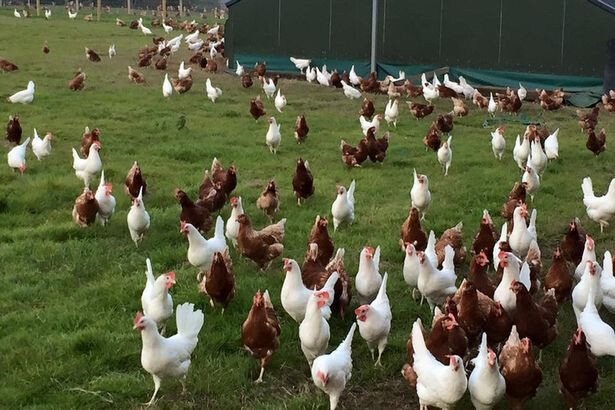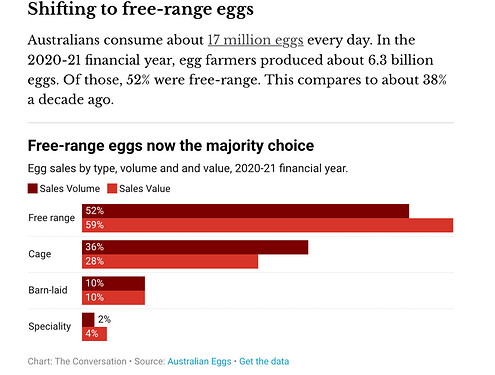Sent mine a few days ago.
thank you, thought it was an in box and didn’t check
I sent my email through (to the soon-to-be-retiring, and therefore possibly uninterested Wayne Swan). I wanted to add that I had to significantly amend the template text as I didn’t feel comfortable being represented as a “consumer who doesn’t want to be RIPPED OFF!!!” by unscrupulous, rapacious commercial operators. In truth, I am concerned about the welfare of the chickens, which is how this whole “free range” movement started. The template text mentioned nothing about the fact that the poor labelling standards actually facilitate ongoing cruelty to living creatures. Anyone with half an eye on the media these days knows the appalling conditions chickens are kept in just so we can have cheap eggs. I keep my own chickens, so I don’t get RIPPED OFF!!! (sorry, but that’s the tone the template gave) - but I still maintain a genuine concern for animal welfare.
Thanks @FarmerRaq, we appreciate the thoughts and we’re happy when people customise the messaging to the best fit.
While not specifically about free ranged eggs, this recent ABC article provides information on why eggs are different colours…
… received a reply …
Thank you for your email regarding free range egg labelling.
A new National Information Standard will come into effect regarding free range eggs on 26 April 2018. The new standard governs the circumstances under which the words ‘Free Range’ can be used to describe eggs, and requires that free range eggs clearly display the stocking density on the package.
On 6 February the Australian Competition and Consumer Commission (ACCC) released new guidelines on the information standard and how they would take enforcement action against egg producers that did not comply. Further information can be found at www.accc.gov.au/publications/free-range-chicken-egg-claims
Labor acknowledges the important role labelling plays in empowering consumers to make choices at the supermarket aisle that are right for them and their families. We welcome that the new Standard requires display of stocking densities on free range egg packaging so that consumers can make their own choice
Labor will consider Member for Mayo’s proposal on its merits.
Warren Snowdon MHR
Member for Lingiari
Bought some eggs today at the markets. Never seen them before. 800g a dozen cost me $8
came home and used the app on it. … now I need to find them weekly.
refusing to upload… last try
Hi @FarmerRaq. Yes, I sincerely don’t want to be RIPPED OFF by fake free range (FFR) producers, not because I’m a miser with anger issues  but because it makes it almost impossible for genuine free-range (GFR) producers to look after their birds and stay in business. If egg buyers can’t tell the difference between GFR breaking even at $5 per dozen and spivs charging $5 for $2 cage eggs, the spivs win and the hens suffer.
but because it makes it almost impossible for genuine free-range (GFR) producers to look after their birds and stay in business. If egg buyers can’t tell the difference between GFR breaking even at $5 per dozen and spivs charging $5 for $2 cage eggs, the spivs win and the hens suffer.
Once the efficient GFR producers are driven out of business there will only be cheap cage eggs, mid-priced cage eggs labeled FR, and very expensive organic/GFR eggs only accessible to the well off.
Federal (Liberal) Member’s reply:
"Thank you for your email to the Hon Karen Andrews. Mrs Andrews appreciates the time you have taken to make her aware of your views and has asked me to respond on her behalf.
The Australian Government supports clear labelling of free range eggs to allow Australian consumers to make an informed purchase. To achieve this, the Australian Government registered a new information standard for labelling of free range eggs, the Australian Consumer Law (Free Range Egg Labelling) Information Standard 2017, on 26 April 2017. The information standard will come into force on 26 April 2018.
The Information Standard deliberately does not tell farmers how to farm or regulate animal welfare as it is purely designed to ensure consumers know what they are buying when they purchase eggs labelled as ‘free range’. The standard requires “free range eggs” be produced by hens that have meaningful and regular outdoor range access during daylight hours of the laying cycle, rather than requiring egg farmers to monitor the movements of every hen on their farm. It also mandates that stocking density is prominently displayed on the packaging of eggs.
The Coalition Government believes that the Information Standard in its current form provides a sensible balance between the views of consumers, advocacy groups and industry, with a focus on informing consumers as to how free range eggs are produced.
Again, thank you for contacting Mrs Andrews and raising your concerns.
Kind regards,
Georgi Tomlinson | Electorate Officer"
I wonder what the following phrase means: “…hens that have meaningful and regular outdoor range access during daylight hours of the laying cycle”
What does “meaningful access” mean? How do you measure it? For the laying cycle, do they mean during the day when hens lay, or their life cycle period when they are laying?
It seem very obfuscated.
With that I feel compelled to post my response from Jenny Macklin (ALP) in its entirety after about 18 calendar days of her serious attention to the matter.
Totally agree @slb - for me the issue is dishonesty and the fact that people are willing to pay more to support an ethically-produced egg (so when the egg has not been ethically produced, the hen and consumer both lose, and the dishonest producer wins). I simply felt that the way the original email was worded sounded a bit Casper Jonquil (for those who watch Mad as Hell) and was focusing on personal injury to my hip pocket rather than the bigger issue of “chicken welfare fraud”.
Probably a moot point anyway, as judging from some of the replies from various MoP, it doesn’t sound like the bill will get much support  My MP hasn’t deigned to reply at all…
My MP hasn’t deigned to reply at all…
Hi Brendan
I did finally get a response from my local pollie - Justine Keay. Pretty standard political guff just reiterating ACCC guidelines but at least she (or her staffer) did reply.
She concluded with the statement: Labor will consider Member for Mayo’s proposal on its merits and thank you again bringing this issue to my attention.
Who knows - we are seeing some egg cartons with improved labelling so maybe she did something on our behalf.
Very interesting @meekas.mum, thanks for letting us know. We’re committed to campaigning for consumers on this issue, so it’s seeing the various responses from politicians is informative. Thanks again for taking the time to in touch with your local politician.
An article regarding claims of egg fraud in WA and possible action by the ACCC.
What should we be expecting of the industry and can it be trusted?
Nearly half the market is now met by free range eggs.
‘What's causing Australia's egg shortage? A shift to free-range and short winter days
This assumes 10,000 hens per hectare allowed out for part of some hours each day is your standard, and is being reliably followed.
All I can add is the free range chooks on one of the neighbours enjoy most of their home home range. The 12 or so chooks also seem to require a further 1000 sqm or so of my side of the fence. I’m not complaining. Just observing their preferred 12 hens per 5000 sqm rule. ![]()
Many people keep their own chooks, some to their ultimate peril. Factoring that into what superficially appears to be premium ‘extra profit’ of the commercial free range farmers?
This:

is not what 10,000 chooks per hectare (one square metre per bird) looks like.
This:
is what 10,000 per hectare looks like. In dry weather they get to dust bath. At that density nothing green will last more than a few days.
The difference between the eggs with high lead and low lead looks at first like backyard-homegrown compared to commercial. That is misleading The real reason for the difference is location.
Inner city chooks hunt and peck on plots of land that have been exposed to lead paint and leaded petrol (in some cases also to dirty industries) for many decades. Country birds have not. Commercial birds either “free range” or live in cages/barns in the country where land is cheaper not in the inner city where it is polluted.

